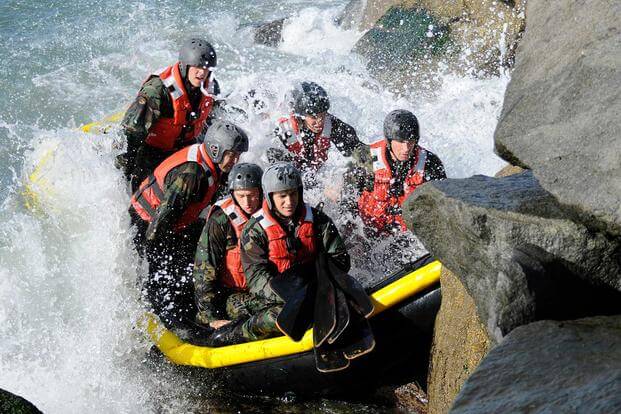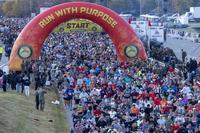If you are considering the Navy SEAL route in your future, there are many steps in the process. Your first step should be to go to the official Navy SEAL website to see the updated standards and requirements. During this consideration process, you should be already in the preparation process for the physical screening test (PST). Learn how to take the PST. That is right; long before you even walk into a recruiter’s office, take the PST and see where you are on the PST calculator scale.
In a related article, Ten Signs Prove You Are Ready to Serve, there are many recommendations, but at this point in the recruiting process, I recommend going into the recruiter’s office when you can ace the PST with the passing to competitive standards.
If you join the delayed entry program too soon without having passed the PST, you will spend your time in DEP focused on the PST. The PST is a test that gets you to BUD/S, not through BUD/S. There are many other things you need to do administratively to get through the recruiting process (ASVAB, CSORT, MEPS, maybe waivers to submit, etc.) See the official link for the administrative issues.
If you can show up crushing the PST on Day 1, you can focus the time you have in DEP on longer runs (four-mile timed runs), building up to longer swims (two miles with fins) and doing more load-bearing work. These types of workouts will have to be done on your own for the most part, but some mentors in the districts get involved with this type of pre-training. Some mentors are stretched pretty thin and need to travel to do swim clinics and PST events for their region.
Once you ace the PST, the mentor will submit your scores into the nationwide draft process, where the Special Warfare community selects the best scores from the recruiting districts from those who are qualified and ready to obtain a contract. Once you get selected, you will be given a shipping date and will know when you go to boot camp.
When you ship for boot camp, your PST should be an easy day to achieve the following scores: sub-nine-minute swim, 80-100 push-ups/sit-ups, 20 pull-ups, nine-minute run. This is to ensure there is no fear of failure at any point in the near future when your PST really counts.
Boot camp, where you will learn how to be in the Navy, is approximately eight weeks long. The recommendation for a future BUD/S student is to go to boot camp in the best shape as possible and use it as a taper or de-loading phase in your training. Physically, you still will have to take the PST, so do not get out of PST shape or you could lose your BUD/S billet if you fail at any point.
Having killer PST scores so you are well above the failure mark is critical, as you will have bad days but still have to perform within the standard.
After boot camp, you will be a bit deconditioned from when you arrived. If you can avoid getting seriously ill, you are ahead of the game. Recovery from these illnesses may delay your progress when you start BUD/S prep. BUD/S prep is a six- to eight-week course where you will be rebuilt to perform at the expected levels of BUD/S standards. You will take more PSTs, an advanced PST with a longer swim (800 and 1000 meters with fins), longer run (four miles timed), along with weightlifting, sprints and agility testing events. See SEAL TAP Test with extra events.
You will arrive at BUD/S and start BUD/S orientation (BO), which is three weeks of administrative tasks, check-in and gear issue, and your introduction to BUD/S workouts. After orientation, you start BUD/S Indoc, which starts the preparation for first phase. Many of the events that you will be required to do in first phase will be taught and practice-tested during Indoc. This is a five- to six-week cycle.
Finally, you start First Phase. This is what you have prepared the past year or more to get to. Now it is game time. “Be competitive and strive to win. You never think about quitting if you think about winning!”
Here is the 10-step checklist to go from civilian to BUD/S student/graduate.
- Train hard. Ace the PST.
- Visit a recruiter (Do ASVAB, CSORT, get through MEPS). Join the Navy/delayed entry program.
- Crush the PST officially with the recruiting district SEAL/EOD/Diver/SWCC/AIRR mentor. You now can get a SO rating (special operator) during DEP.
- Get submitted into the SPECWAR draft.
- Get a BUD/S contract. Spend the remaining time focused on getting through BUD/S and working on any weaknesses (water skills, running, rucking, lifting, swimming with fins, etc.).
- Attend boot camp. Ace PST at boot camp. (#1 goal: Don’t get sick.)
- Attend BUD/S prep. Ace PST, TAP test and rebuild your body. Ace exit PST (longer run/swim).
- Ship to BUD/S. Start in BUD/S orientation (three weeks).
- Start BUD/S Indoc. Indoctrination is a five-week course that prepares you for the challenges of first phase.
- Start Phase 1 BUD/S. This is the toughest phase of the six-month-long course. In the first four weeks alone, the typical class will lose 50%-75% of its size as the fourth week is Hell Week (120 straight hours).
Once you get past these first 10 steps, the real training begins. You will be introduced to combat diving in second phase and land warfare in third phase, learning many of the basic skills of combat diving, land navigation, patrolling, shooting and moving, communicating and demolitions.
After BUD/S, you will attend SEAL qualification training (SQT), which is a six-month course that takes your current skill level and builds it to a level where you are expected to be when you join your SEAL team. SQT takes your current skills and build upon them as well. It teaches you static-line, free-fall parachuting; Survival, Evasion, Resistance and Escape (SERE) school; advanced combat diving; land warfare; cold-weather warfare; and more.
Related Article: Top 10 Things You Should Know Before You Join the Military
Stew Smith is a former Navy SEAL and fitness author certified as a Strength and Conditioning Specialist (CSCS) with the National Strength and Conditioning Association. Visit his Fitness eBook store if you’re looking to start a workout program to create a healthy lifestyle. Send your fitness questions to stew@stewsmith.com.
Want to Learn More About Military Life?
Whether you're thinking of joining the military, looking for fitness and basic training tips, or keeping up with military life and benefits, Military.com has you covered. Subscribe to Military.com to have military news, updates and resources delivered directly to your inbox.



















